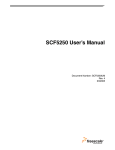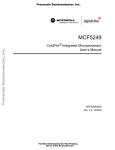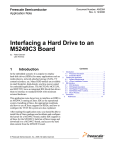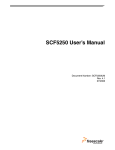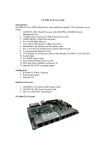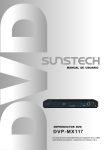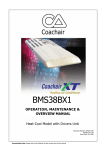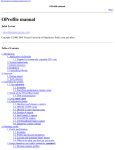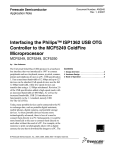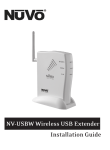Download Building an MP3 Player on uClinux` Using ColdFire“ MCF5249
Transcript
Freescale Semiconductor
Application Note
Document Number: AN3385
Rev. 0, 12/2006
Building an MP3 Player on the
uClinux Operating System Using
ColdFire MCF5249
by: Fabio Estevam
Latin America
1
Introduction
MP3 content has become popular in the PC world and
consumer space (portable media players, USB thumbs,
hard-drive media players, automotive radio, mini
systems, etc.). The ColdFire® devices MCF5249,
MCF5250, and MCF5251 are effective for developing
MP3 solutions due to performance, integrated audio
peripherals, low power, and Freescale Semiconductor’s
extensive software and hardware reference designs.
This application note shows how to run an MP3 decoder
on ColdFire MCF5249 using the uClinux™ operating
system, a variant of Linux that runs on microprocessors
without a memory management unit (MMU).
Instructions also show how to install uClinux, build the
MP3 player application, and play files from a remote
host through the Ethernet.
After reading this note, you can build an uClinux image;
download it to a M5249C3 board; install uClinux
operating system and the toolchain and configure the
kernel for a M5249C3 board; add an MP3 decoder
application to the kernel; and export a directory from the
© Freescale Semiconductor, Inc., 2006. All rights reserved.
Contents
1
2
3
4
Introduction . . . . . . . . . . . . . . . . . . . . . . . . . . . . . . . . . . . 1
1.1 Processor Description . . . . . . . . . . . . . . . . . . . . . . . 2
1.2 Evaluation Board . . . . . . . . . . . . . . . . . . . . . . . . . . . 3
Building the Application . . . . . . . . . . . . . . . . . . . . . . . . . 3
2.1 System Requirements . . . . . . . . . . . . . . . . . . . . . . . 3
2.2 uClinux Installation Process . . . . . . . . . . . . . . . . . . 4
2.3 Adding the MP3 Decoder Application . . . . . . . . . . 10
Conclusion. . . . . . . . . . . . . . . . . . . . . . . . . . . . . . . . . . . 19
References . . . . . . . . . . . . . . . . . . . . . . . . . . . . . . . . . . 19
Introduction
host via network-file system (NFS) and play its content on the M5249C3 board.
1.1
Processor Description
The MCF5249 comes in two packages:
• 144-pin QFP — Runs up to 120 MHz
• 160-pin BGA — Runs up to 140 MHz
8K
Byte
i-Cache
Audio
Module
ColdFire V2
I Addr Gen
I Fetch
PLL
Frequency
Synthesizer
96K
Byte
SRAM
QSPI
Instr Buf
Dec & Sel Op
A Gen & Ex
B
u
s
C
o
n
t
r
o
l
12-bit ADC
IDE
Interface
Flash
Media
Interface
DUART
EMAC
Timers
H/W Divide
GPIOs
I²Cs
Debug
Module
SDRAM
Cntr
& Chip
Selects
DMAs
Figure 1. MCF5249 Block Diagram
Features:
• Enhanced multiply and accumulate (eMAC) unit — Allows the MCF5249 to perform digital signal
processing algorithms such as vocoders used in VoIP applications (G.729, G.723) MP3, WMA,
decoder, and encoding
• Internal SRAM — (96 KB on the MCF5249) Important for tasks (such as supporting the MP3
decoder) because the critical time data and program can be placed in internal SRAM, which has a
faster access time than external SDRAM
• Low power consumption — (1.3 mW/MHz) Suitable for portable devices
• IDE interface — Allows glue-less connection to a hard drive
• Background debug module (BDM) — Flexible debug interface; also allows external flash
programming
• Serial audio interfaces — Supports I2S and EIAJ standards
• SPDIF(IEC958) digital audio interfaces
Building an MP3 Player on the uClinux Operating System Using ColdFire MCF5249, Rev. 0
2
Freescale Semiconductor
Building the Application
•
1.2
SD and MMC interfaces
Evaluation Board
The M5249C3 is the evaluation board for the MCF5249 and the hardware used in this document.
Figure 2. M5249C3 board
M5249C3 features:
• 8 MB of SDRAM
• 2 MB of flash
• External 10/100 ethernet controller
• Two serial ports — One for monitor, one for general purpose
• BDM debug module interface connector — Used with source-level debuggers running on PCs
• IDE connector for glue-less hard-drive connection
• Stereo audio inputs and stereo audio input jacks
• Pre-flashed dBug monitor firmware — Allows access to CPU registers, memory content, and the
ability to download applications to the target from the serial port and over Ethernet
2
Building the Application
The following sections show how to set up the application’s working environment and how to build and
download the MP3 decoder to the M5249C3 under the uClinux operating system.
2.1
•
•
System Requirements
M5249C3 board, a serial cable, and crossover cable
A Linux host computer. The distribution used in the tests was RedHat 9.0®, but you can also run
in different Linux distributions. Enable the NFS and trivial file transfer protocol (TFTP) services
in the Linux host. This may vary among distributions, but activating these services is beyond this
document’s scope. A terminal emulator such as minicon is also needed for communicating with the
M5249C3 board.
Building an MP3 Player on the uClinux Operating System Using ColdFire MCF5249, Rev. 0
Freescale Semiconductor
3
Building the Application
2.2
uClinux Installation Process
Installing on the host machine:
1. Download the latest uClinux distribution from http://www.uclinux.org/pub/uClinux/dist/. (This
document was written when the latest version was uClinux-dist-20051110.) The current version is
uClinux-dist-20060803, which is a full-source package containing kernel (2.0, 2.4, and 2.6)
libraries and application code.
2. Download the toolchain for ColdFire (http://www.uclinux.org/pub/uClinux/m68k-elf-tools/). This
application note uses the m68k-elf-tools-20030314. It contains the cross-compiler and assembler
for ColdFire targets.
3. As root, install the toolchain in the Linux host sh m68k-elf-tools-20030314”
4. Log in as a standard user.
5. Copy the uClinux source package file uClinux-dist-200511110.tar.gz into /home/ directory, for
example:/home/fabio).
6. Go to /home/user directory and extract tar –xzvf uClinux-dist-200511110.tar.gz
2.2.1
Generating a uClinux Image and Downloading it to the Target
After the toolchain and uClinux distribution are installed in the host computer, build an image for the
M5249C3 then download it to the board.
1. Configure the kernel and target options. Go to uClinux-dist directory, then:
>> cd /home/user/uClinux-dist
>> make menuconfig
The following window should appear:
Figure 3. Menuconfig Window
Building an MP3 Player on the uClinux Operating System Using ColdFire MCF5249, Rev. 0
4
Freescale Semiconductor
Building the Application
2. Select vendor/settings.
3. Select the vendor and M5249C3 as the target.
Figure 4. Vendor and Target Selection
4. Select kernel linux-2.4 and uC-lib as libc.
Figure 5. Kernel and Libc Selection
Building an MP3 Player on the uClinux Operating System Using ColdFire MCF5249, Rev. 0
Freescale Semiconductor
5
Building the Application
5. Select Yes to save the kernel configuration.
Figure 6. Save Kernel Configuration Window
6. Create a folder called /tftpboot that contains the generated image.bin file. As root (the “su”
command enters in root mode):
>>mkdir /tftpboot
>>chmod 777 /tftpboot
Going back to user mode (command is “su user”)
>> make dep ; make
7. After a successful build process, an image.bin file must have been placed in the /tftpboot folder.
The image.bin file combines the kernel and root-file systems.
Downloading the image to the M5249C3:
1. Connect the serial cable from the host PC to the M5249C3.
2. In the host, run a terminal emulator such as minicon and set it to a baud rate of 19200 bps, 8 bits,
no parity, no software and no hardware flow control.
Building an MP3 Player on the uClinux Operating System Using ColdFire MCF5249, Rev. 0
6
Freescale Semiconductor
Building the Application
3.
Power up the M5249C3. The following messages appear:
Hard Reset
DRAM Size: 8M
ColdFire MCF5249 EVS Firmware
v3a.1b.1c
(Build 4 on Mar 04 2003 15:38:14)
Enter 'help' for help.
dBUG
dBUG>
Refer to the M5249C3 User Manual for a detailed list of commands supported by the dBug monitor.
Ensure that the TFTP service is enabled and that /tftpboot folder can be exported. The TFTP package is
not installed by default in RedHat 9.0 and also in some other Linux distributions. In RedHat 9.0, the
configuration file for TFTP server is /etc/xinetd.d/tftp (listed below):
service tftp
{
disable
socket_type
protocol
wait
user
server
server_args
per_source
cps
flags
}
= no
= dgram
= udp
= yes
= root
= /usr/sbin/in.tftpd
= -s /tftpboot
= 11
= 100 2
= IPv4
Insert a crossover cable between the host PC and the M5249C3 board.
NOTE
You can use a normal cable and connect the PC and the M5249C3 in a
network. By default, the DHCP application is enabled for the M5249C3,
and the board can retrieve an IP address if the network has DHCP capability.
1. In dBug prompt, type “show”
dBug>set server 192.168.0.1
dBug>set client 192.168.0.2
2. In the host: ifconfig eth0 192.168.0.1
dBug>dn –i image.bin
This command requests a TFTP transfer and sends the image.bin file located at /tftpboot folder from the
host.
Building an MP3 Player on the uClinux Operating System Using ColdFire MCF5249, Rev. 0
Freescale Semiconductor
7
Building the Application
The image transferred through TFTP is now loaded into the external SDRAM of the M5249C3. To execute
the uClinux kernel, jump to its initial location, 0x20000. The command in dBug is dBug> go 20000
The kernel boot message should start:
Linux version 2.4.31-uc0 (root@localhost) (gcc version 2.95.3 20010315 (release)(ColdFire patches 20010318 from http://fi6
uClinux/COLDFIRE(m5249)
COLDFIRE port done by Greg Ungerer, [email protected]
Flat model support (C) 1998,1999 Kenneth Albanowski, D. Jeff Dionne
On node 0 totalpages: 2048
zone(0): 0 pages.
zone(1): 2048 pages.
zone(2): 0 pages.
Kernel command line:
Calibrating delay loop... 92.56 BogoMIPS
Memory available: 6052k/8192k RAM, 0k/0k ROM (775k kernel code, 221k data)
kmem_create: Forcing size word alignment - mm_struct
kmem_create: Forcing size word alignment - filp
Dentry cache hash table entries: 1024 (order: 1, 8192 bytes)
Inode cache hash table entries: 512 (order: 0, 4096 bytes)
kmem_create: Forcing size word alignment - inode_cache
Mount cache hash table entries: 512 (order: 0, 4096 bytes)
kmem_create: Forcing size word alignment - bdev_cache
kmem_create: Forcing size word alignment - cdev_cache
kmem_create: Forcing size word alignment - kiobuf
Buffer cache hash table entries: 1024 (order: 0, 4096 bytes)
Page-cache hash table entries: 2048 (order: 1, 8192 bytes)
POSIX conformance testing by UNIFIX
Linux NET4.0 for Linux 2.4
Based upon Swansea University Computer Society NET3.039
Initializing RT netlink socket
Starting kswapd
kmem_create: Forcing size word alignment - file_lock_cache
kmem_create: Forcing size word alignment - nfs_read_data
kmem_create: Forcing size word alignment - nfs_write_data
ColdFire internal UART serial driver version 1.00
ttyS0 at 0x100001c0 (irq = 73) is a builtin ColdFire UART
ttyS1 at 0x10000200 (irq = 74) is a builtin ColdFire UART
M5249AUDIO: (C) Copyright 2002, Greg Ungerer ([email protected])
M5249AUDIO: DMA channel=0, irq=120
Bad boy: audio(DMA) (at 0x0007ede8) called request_irq without a dev_id!
kmem_create: Forcing size word alignment - blkdev_requests
SMSC LAN91C111 Driver (v2.0), (Linux Kernel 2.4 + Support for Odd Byte) 09/24/01 by Pramod Bhardwaj
(pramod.bhardwaj@)eth0: SMC91C11xFD(rev:1) at 0xe0000300 IRQ:166 MEMSIZE:8192b NOWAIT:0 ADDR:
00:cf:52:49:c3:04
SLIP: version 0.8.4-NET3.019-NEWTTY (dynamic channels, max=256).
CSLIP: code copyright 1989 Regents of the University of California.
Blkmem copyright 1998,1999 D. Jeff Dionne
Blkmem copyright 1998 Kenneth Albanowski
Blkmem 1 disk images:
0: 119564-1FB163 [VIRTUAL 119564-1FB163] (RO) <ROMFS>
RAMDISK driver initialized: 16 RAM disks of 4096K size 1024 blocksize
PPP generic driver version 2.4.2
PPP MPPE compression module registered
NET4: Linux TCP/IP 1.0 for NET4.0
Building an MP3 Player on the uClinux Operating System Using ColdFire MCF5249, Rev. 0
8
Freescale Semiconductor
Building the Application
NET4: Unix domain sockets 1.0/SMP for Linux NET4.0.
FAT: bogus logical sector size 49024
VFS: Mounted root (romfs filesystem) readonly.
Freeing unused kernel memory: 24k freed (0xfe000 - 0x103000)
Shell invoked to run file: /etc/rc
Command: hostname uClinux
Command: /bin/expand /etc/ramfs.img /dev/ram1
Command: mount -t proc proc /proc
mount: bb_xasprintf: Unknown error 0
pid 9: failed 256
Command: mount -t ext2 /dev/ram1 /var
Command: mkdir /var/tmp
Command: mkdir /var/log
Command: mkdir /var/run
Command: mkdir /var/lock
Command: mkdir /var/empty
Command: ifconfig lo 127.0.0.1
Command: route add -net 127.0.0.0 netmask 255.0.0.0 lo
Command: dhcpcd -p -a eth0 &
[13]
Command: cat /etc/motd
Welcome to
____ _ _
/ __| ||_|
_
_| | | | _ ____ _
_ _ _
| | | | | | || | _ \| | | |\ \/ /
| |_| | |__| || | | | | |_| |/
\
| ___\____|_||_|_| |_|\____|\_/\_/
| |
|_|
For further information check:
http://www.uclinux.org/
Execution Finished, Exiting
Sash command shell (version 1.1.1)
/>
You can now manually set up the IP address of the board by “ifconfig eth0 192.168.0.2”.
NOTE
If the M5249C3 is connected to a network, you can get an IP address
through DHCP. The default setting of uClinux enables the DHCP daemon.
You can try to ping the host: “ping 192.168.0.1”. Press “CTRL-C” to stop the ping process.
Building an MP3 Player on the uClinux Operating System Using ColdFire MCF5249, Rev. 0
Freescale Semiconductor
9
Building the Application
/> ifconfig eth0 192.168.0.2
/> ping 192.168.0.1
PING 192.168.0.1 (192.168.0.1): 56 data bytes
64 bytes from 192.168.0.1: icmp_seq=0 ttl=64 time=5.9 ms
64 bytes from 192.168.0.1: icmp_seq=1 ttl=64 time=2.9 ms
64 bytes from 192.168.0.1: icmp_seq=2 ttl=64 time=2.9 ms
64 bytes from 192.168.0.1: icmp_seq=3 ttl=64 time=2.9 ms
64 bytes from 192.168.0.1: icmp_seq=4 ttl=64 time=2.9 ms
--- 192.168.0.1 ping statistics --5 packets transmitted, 5 packets received, 0% packet loss
2.3
2.3.1
Adding the MP3 Decoder Application
Audio Hardware and Device Driver
Two serial audio interfaces are connected on the M5249C3 board:
• I2S1 — Can be used as input and output interface and is connected to an A/D (AK5353)
• I2S2 — Output-only interface connected to AK4360 (D/A) as shown below. Analog stereo output
is J1.
Building an MP3 Player on the uClinux Operating System Using ColdFire MCF5249, Rev. 0
10
Freescale Semiconductor
Building the Application
Figure 7. Audio Output Circuitry
The uClinux audio driver for the MCF5249 is located at
/home/…/uClinux-dist/drivers/char/m5249audio.c, and it configures I2S2 to operate with a 44.1 kHz
sampling frequency (LRCK signal), the common sampling rate value for CD-quality audio. If another
sampling frequency is used (for example 8 kHz, which is used for voice applications), a different crystal
frequency may be needed.
NOTE
The MP3 content is read via NFS from the server, and the decoder task
decodes the file. In the MCF5249, an audio bus can receive and transmit
audio information.
Building an MP3 Player on the uClinux Operating System Using ColdFire MCF5249, Rev. 0
Freescale Semiconductor
11
Building the Application
Serial
Audio
Receivers
1, 3 & 4
Digital Audio
Receivers
1&2
CPU Bus
PDOR1
PDOR2
PDOR3
Block
Encoder
Audio Bus -- 40-bit Time Multiplexed Bus
Source
Select
Source
Select
Source
Select
Source
Select
Source
Select
FIFO
6 Fields
FIFOs
6 fields each
FIFO
6 Fields
FIFO
6 Fields
FIFO
6 Fields
Block
Decoder
Digital Audio
Transmitter
Serial Audio
Transmitters
1&2
IIS output to
DAC / HP driver
PDIR1
PDIR2
PDIR3
CPU Bus
Figure 8. Digital Audio Path
The decoded data transfers from the CPU to one of three processor-data-output registers. In our case,
PDOR1 transmits data from the CPU to the dedicated 40-bit audio bus. From the audio bus, you can select
which interface outputs the audio: digital-audio interface or serial-audio interface. We use the serial audio
interface (I2S2) to transmit data to the DAC. On the MCF5249, I2S1 is a bi-directional serial audio
interface; I2S2 is output only; I2S3 and I2S4 are input-only.
2.3.2
Using Freescale’s Optimized MP3 Decoder
After uClinux is running on the M5249C3 board, go to /bin directory (>cd /bin) and then ls. An MP3 player
application comes as default with the uClinux build for MCF5249. We do not use it in this application
because this version is not optimized. Freescale provides an optimized version of a MP3 decoder that uses
the eMAC feature from the MCF5249. To gain more performance, place the MP3 decoder data and
program into internal SRAM, so the critical time data and program from the decoder do not need fetched
from external SDRAM. A sample rate converter (SRC) also allows playing MP3 files at these sampling
rates: 8 kHz, 11 kHz, 12 kHz, 16 kHz, 22.05 kHz, 24 kHz, 32 kHz, or 48 kHz to 44.1 kHz
Memory usage of Freescale’s MP3 decoder:
Building an MP3 Player on the uClinux Operating System Using ColdFire MCF5249, Rev. 0
12
Freescale Semiconductor
Building the Application
Table 1. MP3 Memory Usage
Code
Stack
Tables and Data
Scratch
MP3 decoder
19.5 KB
1 KB
19.5 KB SRAM
6.5 KB DRAM
7 KB
SRC
13.2 KB
1 KB
5.9 KB SRAM
3.6 KB DRAM
2.3 KB
To download the MP3 decoder for uClinux, go to the MCF5249 product summary page
http://www.freescale.com/webapp/sps/site/prod_summary.jsp?code=MCF5249. Scroll down to the
libraries section (CFMP3LINUXDEC).
2.3.3
Adding the MP3 and SRC Libraries into the Kernel
The steps to add a new application into the uClinux kernel are shown at
/home/…/uClinux-dist/Documentation/Adding-User-Apps-HOWTO. Follow these steps to add the MP3
player application.
1. Change the current working directory to uClinux-dist directory.
2. Create a directory in ./user/ as uClinux_Motomp3.
3. Create a directory in ./user/uClinux_Motomp3 as lib.
4. Copy the following files to ./user/uClinux_Motomp3: mp3ld.ld, uClinux_Motomp3.c,
uClinux_MP3D_decoder.h and Makefile
5. Copy the following files to ./user/uClinux_Motomp3/lib/: liblinuxmp3dec.a and liblinuxsrc.a
6. Add dir_$(CONFIG_USER_MP3_FREESCALE) += uClinux_Motomp3 to the appropriate place
in Makefile in ./user/Makefile
7. Look for the original MP3PLAY application and place the CONFIG_USER_MP3_FREESCALE
in the next line.
8. Add bool ‘uClinux_Motomp3’ CONFIG_USER_MP3_FREESCALE to the miscellaneous
applications under the audio tools section in ./config/config.in
comment 'Audio tools'
#bool 'uClinux_Motomp3'CONFIG_USER_MP3_FREESCALE
bool 'mp3play'
CONFIG_USER_MP3PLAY_MP3PLAY
9. Add the following lines to ./config/Configure.help:
CONFIG_USER_MP3_FREESCALE
Optimized MP3 decoder
10. Go to menuconfig (>>make menuconfig).
11. Go to kernel/library/default Selection - - - >. Select.
Building an MP3 Player on the uClinux Operating System Using ColdFire MCF5249, Rev. 0
Freescale Semiconductor
13
Building the Application
12. Mark customize kernel settings. Select.
13. Exit.
14. Exit.
15. Yes for saving the kernel configuration.
16. Go to kernel hacking - - - > Select.
Building an MP3 Player on the uClinux Operating System Using ColdFire MCF5249, Rev. 0
14
Freescale Semiconductor
Building the Application
17. Mark non power-of-2 kernel allocator
18. Exit.
19. Exit.
20. Yes for saving the kernel configuration. (>> make menuconfig)
21. Go to kernel/library/defaults selection - - - > Select.
Building an MP3 Player on the uClinux Operating System Using ColdFire MCF5249, Rev. 0
Freescale Semiconductor
15
Building the Application
22. Mark customize vendor/user setting. Select.
23. Exit.
24. Exit.
25. Yes for saving the kernel configuration.
26. Go to miscellaneous applications - - - > Select.
Building an MP3 Player on the uClinux Operating System Using ColdFire MCF5249, Rev. 0
16
Freescale Semiconductor
Building the Application
27. Scroll down to the - - - audio tools section. Mark uClinux_motomp3.
28. Exit.
29. Exit.
30. Yes for saving the kernel configuration.
31. For building the new image:
>> make dep; make
Building an MP3 Player on the uClinux Operating System Using ColdFire MCF5249, Rev. 0
Freescale Semiconductor
17
Building the Application
32. The new image (image.bin) is automatically copied to /tftpboot directory
33. Download the generated image.bin file to the M5249C3 (Section 2.2.1, “Generating a uClinux
Image and Downloading it to the Target”).
2.3.4
Exporting Files via NFS and Playing MP3 Files Remotely
Create a folder in the host side with MP3 content. Make it exportable via NFS. For RedHat 9.0 the
/etc/exports is:
#
/mp3 192.168.0.*(rw)
The following directory structure created an MP3 in the host (/mp3):
> Beatles
> Deep Purple
> Eric Clapton
> Chorinho
Each directory above contains MP3 files.
For the target to access the MP3 folder in the host, the NFS service should run on the host and the following
commands must be sent in uClinux:
portmap &
mount –o rsize=1024, wsize=1024 192.168.0.1:/mp3 /mnt
Now in the /mnt directory, all the content of /mp3 can be accessed from the M5249C3 board:
-> cd /mnt
->cd Beatles
-> ls –al
total 15516
drwxr-xr-x
-rwxr-xr-x
-r-xr-xr-x
-rwxr-xr-x
2
1
1
1
root
root
root
root
root
root
root
root
4096
4846741
5258013
3813463
May 21 21:43
Jan 8 2003
Jan 8 2003
Mar 1 22:27
.
something.mp3
yesterday.mp3
getback.mp3
> uClinux_Motomp3 something.mp3 &
NOTE
The ampersand (&) symbol denotes that the MP3 player application runs in
background mode. This means other applications and uClinux commands
can execute while the MP3 file is being decoded and played.
The above command decodes the something.mp3 file and the audio is played on the stereo audio output
(connector J1).
Building an MP3 Player on the uClinux Operating System Using ColdFire MCF5249, Rev. 0
18
Freescale Semiconductor
Conclusion
3
Conclusion
This application note presented the steps for adding an optimized MP3 and sample rate converter (SRC)
libraries into uClinux. uClinux supports many ColdFire device drivers, which can generate many
applications such as hard-disk based MP3 players, SD and MMC MP3 players, Wi-Fi connectivity, etc.
You can add LCD and keypads device drivers to the system. An overview of the powerful and flexible
audio capabilities of the MCF5249/5250/5251 were also presented.
4
References
1. MCF5249 ColdFire Integrated Microprocessor User Manual
2. M5249C3 Reference Board User Manual
3. MP3 Decoder on uClinux Demo User Manual
Building an MP3 Player on the uClinux Operating System Using ColdFire MCF5249, Rev. 0
Freescale Semiconductor
19
How to Reach Us:
Home Page:
www.freescale.com
E-mail:
[email protected]
USA/Europe or Locations Not Listed:
Freescale Semiconductor
Technical Information Center, CH370
1300 N. Alma School Road
Chandler, Arizona 85224
+1-800-521-6274 or +1-480-768-2130
[email protected]
Europe, Middle East, and Africa:
Freescale Halbleiter Deutschland GmbH
Technical Information Center
Schatzbogen 7
81829 Muenchen, Germany
+44 1296 380 456 (English)
+46 8 52200080 (English)
+49 89 92103 559 (German)
+33 1 69 35 48 48 (French)
[email protected]
Japan:
Freescale Semiconductor Japan Ltd.
Headquarters
ARCO Tower 15F
1-8-1, Shimo-Meguro, Meguro-ku,
Tokyo 153-0064
Japan
0120 191014 or +81 3 5437 9125
[email protected]
Asia/Pacific:
Freescale Semiconductor Hong Kong Ltd.
Technical Information Center
2 Dai King Street
Tai Po Industrial Estate
Tai Po, N.T., Hong Kong
+800 2666 8080
[email protected]
For Literature Requests Only:
Freescale Semiconductor Literature Distribution Center
P.O. Box 5405
Denver, Colorado 80217
1-800-441-2447 or 303-675-2140
Fax: 303-675-2150
[email protected]
Document Number: AN3385
Rev. 0
12/2006
Information in this document is provided solely to enable system and software
implementers to use Freescale Semiconductor products. There are no express or
implied copyright licenses granted hereunder to design or fabricate any integrated
circuits or integrated circuits based on the information in this document.
Freescale Semiconductor reserves the right to make changes without further notice to
any products herein. Freescale Semiconductor makes no warranty, representation or
guarantee regarding the suitability of its products for any particular purpose, nor does
Freescale Semiconductor assume any liability arising out of the application or use of any
product or circuit, and specifically disclaims any and all liability, including without
limitation consequential or incidental damages. “Typical” parameters that may be
provided in Freescale Semiconductor data sheets and/or specifications can and do vary
in different applications and actual performance may vary over time. All operating
parameters, including “Typicals”, must be validated for each customer application by
customer’s technical experts. Freescale Semiconductor does not convey any license
under its patent rights nor the rights of others. Freescale Semiconductor products are
not designed, intended, or authorized for use as components in systems intended for
surgical implant into the body, or other applications intended to support or sustain life,
or for any other application in which the failure of the Freescale Semiconductor product
could create a situation where personal injury or death may occur. Should Buyer
purchase or use Freescale Semiconductor products for any such unintended or
unauthorized application, Buyer shall indemnify and hold Freescale Semiconductor and
its officers, employees, subsidiaries, affiliates, and distributors harmless against all
claims, costs, damages, and expenses, and reasonable attorney fees arising out of,
directly or indirectly, any claim of personal injury or death associated with such
unintended or unauthorized use, even if such claim alleges that Freescale
Semiconductor was negligent regarding the design or manufacture of the part.
Freescale™ and the Freescale logo are trademarks of Freescale Semiconductor, Inc.
All other product or service names are the property of their respective owners.
© Freescale Semiconductor, Inc. 2006. All rights reserved.
RoHS-compliant and/or Pb-free versions of Freescale products have the functionality
and electrical characteristics as their non-RoHS-compliant and/or non-Pb-free
counterparts. For further information, see http://www.freescale.com or contact your
Freescale sales representative.
For information on Freescale’s Environmental Products program, go to
http://www.freescale.com/epp.




















